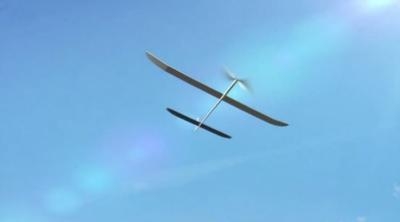Structural Failure Caused By Overspeed Condition
A prototype UAV operated by Google went down last May because of a structural failure, the NTSB said in a probable cause report released Friday.

According to the report, on May 1, 2015 at 11:07 Mountain Daylight Time (MDT), a Titan Solara 50 solar-powered unmanned experimental aircraft registration N950TA crashed shortly after takeoff, near Otto, New Mexico. The aircraft was operated as a scaled, proof of concept test flight. The aircraft was destroyed, there were no injuries.
According to the operator, at 11:02:43 the aircraft began a controlled winch tow and rolled on the ground until liftoff. After the tow release at approximately 30 ft above ground level (AGL), the pilot transitioned to flying the aircraft via instruments and the aircraft was powered up to full throttle for a straight ahead climb. The pilot immediately recognized that the instruments were exhibiting complicating latency and focused on flying the aircraft to a safe altitude and position where the external pilot (copilot) could take control and visually land the aircraft.
The pilot initiated a left hand turn when the aircraft reached approximately 160 feet AGL, which continued until the aircraft reached approximately 385 feet AGL. During this time the pilot made two power reductions, attempting to stabilize the aircraft at an altitude and heading acceptable for handover to the copilot to conduct an external visual landing. Handover of controls to the copilot was not attempted during the flight.
The operator indicated that the aircraft then encountered significant thermal air mass activity and began to both climb and exceed its design airspeed for an extended period of time. Visible deformation of the wing structure was witnessed by ground personnel during the overspeed condition. It achieved a maximum altitude of approximately 520 feet AGL just prior to structural failure of the left outboard wing. These thermal events were not immediately evident to the pilot due to latency of the aircraft instruments. It is believed the subsequent wing deformation caused the aircraft to begin an uncontrollable right hand turn that the pilot was unable to arrest.

Coincident with the significant wing deformation, the aircraft began an uncontrollable and erratic flight path roughly straight ahead in a rapid descent. The left outboard wing section separated from the aircraft during the first portion of the descent and the right outboard wing section separated later in the descent. The aircraft impacted the ground at 11:06:59 with the majority of the structure intact and in a nose down attitude. There were no meteorological indicators that clearly showed evidence of significant pre-launch thermal activity in the test flight area.
The aircraft was destroyed when it struck the ground in a rural unpopulated area. Local terrain surrounding the takeoff area, intended landing area (same as takeoff location), and accident site consisted of flat desert grassland.
The National Transportation Safety Board determines the probable cause(s) of this accident as follows:
structural failure of the left wing due to an overspeed condition.
(Image from file)
 ANN's Daily Aero-Term (04.20.24): Light Gun
ANN's Daily Aero-Term (04.20.24): Light Gun Aero-News: Quote of the Day (04.20.24)
Aero-News: Quote of the Day (04.20.24) ANN's Daily Aero-Linx (04.21.24)
ANN's Daily Aero-Linx (04.21.24) Aero-News: Quote of the Day (04.21.24)
Aero-News: Quote of the Day (04.21.24) ANN's Daily Aero-Term (04.21.24): Aircraft Conflict
ANN's Daily Aero-Term (04.21.24): Aircraft Conflict




